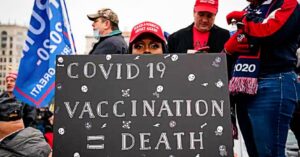A people without the knowledge of their history, origin and culture is like a tree without roots.
– Marcus Garvey, Jamaican political activist
Once there was a very different way to win progressive victories, so different that few can even imagine it. Fewer still believe it could have had the power it must have had to accomplish what it did. Today it is revered but no longer comprehended.
That knowledge has been stamped out by radicals, who always seek to capitalize on the success of others by disparaging their success and claiming that radicalism could do so much more.
I am, of course, speaking of the civil rights movement. We can’t reproduce it now; times have changed. It took decades to develop the principles of nonviolent direct action. But I think we can at least learn from it that “going high” does not mean what some radicals claim: “putting up with injustice” while being “cheerful throughout” (see Ch. 9). “Going high means taking the harder path. …standing fierce against hatred while remembering that we are one nation under God,” as Michelle Obama explained in her convention speech. And as the civil rights movement proved, it’s more powerful than going low, if you’re looking for positive social change.
[Image of Freedom Riders]
A few of the Freedom Riders booked in Jackson, Mississippi
The First Freedom Riders
John Lewis has been a member of the House of Representatives from Georgia since 1987. But on May 9, 1961, he was on one of the two buses making the first Freedom Ride from Washington, D.C., to Jackson, Mississippi. Al Bigelow, another Freedom Rider, was a 55-year-old White man. He had graduated from Harvard in 1929, studied architecture at MIT and designed buildings for the 1939 World’s Fair in New York. In WWII, he served as commander of a submarine chaser and a destroyer escort.
As one of the buses carrying the Freedom Riders crossed into South Carolina, the first deep-South state that they entered, it made a stop in Rock Hill. As Lewis reported in his 1998 memoir, Walking with the Wind:
As Al Bigelow and I approached the “WHITE” waiting room in the Rock Hill Greyhound terminal, I noticed a large number of young White guys hanging around the pinball machines in the lobby. “Other side, Nigger,” one said. He pointed to a door with a sign that said “COLORED.”
“I have a right to go in there,” I said, speaking carefully and clearly, “on the grounds of the Supreme Court decision in the Boynton case.”
“Shit on that,” one of them said. The next thing I knew, a fist smashed the right side of my head. Then another hit me square in the face. As I fell to the floor, I could feel feet kicking me hard in the sides. I could taste blood in my mouth.
At that point Al Bigelow stepped in, placing his body between mine and these men. It had to look strange to these guys to see a big, strong White man putting himself in the middle of a fistfight like this, not ready to throw a punch, but not frightened either.
They hesitated for an instant. Then they attacked Bigelow, who did not raise a finger. It took several blows to drop him to one knee. At that point, Genevieve Hughes, who had also been on the bus, stepped in the way and was knocked to the floor.
Fifty years later, Elwin Wilson, the man who twice smashed the 21-year-old John Lewis in the face, remembered it like this:
What happened was, after he was beat and bloody and all, the policeman came up and asked him, he said, “Do y’all want to take out warrants?” He said, “No.” He said, “We’re not here to cause trouble.” He said, “We’re here for people to love each other.” … The thought, it comes in my mind so many times, what he said he wasn’t out to harm nobody.
A little earlier, Wilson had called the local paper in Rock Hill, confessed to the 1961 beating, and said he wanted to apologize. He did apologize to two local civil-rights groups. Lewis read about this and invited Wilson to Washington. Wilson told Lewis that he had tried to block the incident out of his mind for years but just couldn’t. He apologized to Lewis, who commented, “I think it takes a lot of raw courage to be willing to come forward the way he did.”
Birmingham. When John Lewis’ bus arrived in Birmingham, Alabama, well-known CBS anchorman Howard K. Smith was on the scene to report on what became known as the Mother’s Day Riot. “The riots have not been spontaneous outbursts of anger,” he reported in one broadcast, “but carefully planned and susceptible to having been easily prevented or stopped had there been a wish to do so.”
White Freedom Riders were singled out by the mob for especially severe beatings. Jim Peck, a longtime White pacifist who was in charge of this first phase of the Freedom Ride, was knocked unconscious and was refused treatment at the all-White hospital but was eventually treated at another. The “rule of barbarism in Alabama,” said Smith of CBS, must bow to the “rule of law and order — and justice — in America.”
Diane Nash. The Freedom Riders were making their point effectively, but the Congress of Racial Equality (CORE), which had organized the Rides, decided they had become too dangerous. Attorney General Bobby Kennedy’s man on the scene, John Seigenthaler, arranged a flight for those who wanted to continue to New Orleans, their intended final destination.
Diane Nash wasn’t buying it. Nash felt that if violence was allowed to halt the Freedom Rides, the movement would be set back years.
A founding member of CORE, she had orchestrated the 1960 sit-ins that desegregated Nashville’s downtown lunch counters. Trained in Gandhi’s nonviolent direct action as head of the Fisk University branch of the Student Nonviolent Coordinating Committee (SNCC), she had recruited John Lewis and other Freedom Riders.
Nash convinced CORE of her view that they should continue by bus, and soon Bobby Kennedy got word of this. Here’s how Seigenthaler remembers what happened next:
My phone in the hotel room rings and it’s the attorney general. “Who the hell is Diane Nash? Call her and let her know what is waiting for the Freedom Riders.” So I called her. I said, “I understand that there are more Freedom Riders coming down from Nashville. You must stop them if you can.”
Her response was, “They’re not gonna turn back. They’re on their way to Birmingham and they’ll be there shortly.” … I felt my voice go up another decibel and another and soon I was shouting, “Young woman, do you understand what you’re doing? Do you understand you’re gonna get somebody killed?”
There was a pause, and then she said, “Sir, you should know, we all signed our last wills and testaments last night before they left. We know someone will be killed. But we cannot let violence overcome nonviolence.”
Montgomery. The Freedom Ride continued from Birmingham, protected by the Alabama State Highway Patrol until it reached the city limits of Montgomery. Then all protection vanished. As the Freedom Riders disembarked in Montgomery, all was quiet — until they were ambushed from all sides by a mob led by the Klan.
The mob brutally attacked John Lewis and Bernard Lafayette. William Barbee was beaten unconscious and suffered injuries that would later shorten his life. Two White women were pulled from a cab as they tried to escape and were beaten by the mob.
John Seigenthaler, who was there as an observer, tried at one point to help one of the female Freedom Riders being pursued in the street. He was pulled from his car and beaten with a tire iron. His skull fractured, he was left unconscious in the street.
James Zwerg, a White student from Wisconsin and a friend of John Lewis, was beaten unconscious by the mob. While unconscious, three men held him up while a woman kicked him in the groin. He spent five days in the hospital, the first two unconscious.
But as Zwerg recalls, “If you want to talk about heroism, consider the Black man who probably saved my life. This man in coveralls, just off work, happened to walk by as my beating was going on and said ‘Stop beating that kid. If you want to beat someone, beat me.’ And they did. He was still unconscious when I left the hospital. I don’t know if he lived or died.”
The outcome. Thousands joined in the Freedom Rides. More than 300 Freedom Riders spent much of the summer in jail in Jackson, Mississippi. Finally, on Nov. 1, 1961, the Interstate Commerce Commission issued a ruling to enforce the Supreme Court’s Boynton decision.
But the larger impact was the change in public understanding. The national news had been filled with images, reporting and commentary that exposed the nature of Southern segregation. It suddenly became clear to millions of Americans not only that segregation was part of the South’s legal system but how such laws were enforced. Yes, they were enforced by the terrorism of the Klan. But now it was seen that the Klan had the active support of state and local governments.
Perhaps even more shocking to the larger White community was the fact that this terrorism would be, and was, directed at any Whites who openly advocated challenging Jim Crow laws. Even a close friend and assistant to Attorney General Robert Kennedy would be beaten unconscious and left in the street when he dared to help a young woman, a Freedom Rider, who had done nothing illegal or offensive.
Conclusion
In my view, the civil rights movement was the most advanced political movement this country has seen. It was nothing like the radical movements that followed on its heels and nothing like today’s politics. Its most active phase, from Rosa Parks’ arrest to the 1964 civil rights bill, took more than eight years. And its strategy and tactics took decades to develop.
But what they accomplished was astonishing. They defeated the system of Jim Crow laws that had been in place for nearly 100 years, had spread to most states to some extent and were enforced by domestic terrorists backed by law enforcement in the South. These laws covered most aspects of public life and even private social and business relationships between Whites and Blacks.
Besides ending Jim Crow, the movement also contributed substantially to the passage of Johnson’s War on Poverty programs such as Medicare, Medicaid, food stamps, the Job Corps, Vista, expanded Social Security benefits and subsidies for low-income schools.
One common misunderstanding of the strategy of nonviolence is that it is simply a moral code. That aspect of it is important. But the nonviolent direct action used in the civil rights movement was a product of Gandhi’s struggle to free India as well as the struggle to end Jim Crow. In both cases, the strategy was heavily influenced by the desire to win. And so it was designed to be powerful and effective. Demonstrations were strategically designed and planned.
Much has been forgotten, but a little of the strategy and power of the civil rights movement may now be rediscovered because of the success of the George Floyd protests. The power of this strategy comes from its moral force. I’m convinced that Michelle Obama is channeling the civil rights movement when she says, “When they go low, we go high.” That is not just a moral conviction; she understands its power.
The Power of the George Floyd Protests
“I can’t believe I’m going to say this, but I see hope. I see progress right now, at this moment.” Eleven days after a police officer murdered George Floyd, the renowned black author, Ta-Nehisi Coates, known for his radicalism and pessimistic views on race relations, had changed his mind. That he can be so open-minded despite his radicalism gives me hope that other radicals can do the same.
What impressed Coates and his father, who had seen the 1968 riots after Martin Luther King Jr.’s assassination, was that the demonstrations included so many Whites. The 1968 riots had included none, had destroyed huge amounts of black property, and dozens of Blacks had been killed by the police.
His father compared the change since 1968 with the change between 1900 and MLK’s March on Washington in 1963. Both changes were enormous, and both happened incrementally. His father told him that in 1968, four years after passage of the civil rights bill, the present demonstrations would have been unimaginable.
Coates had almost completely missed this enormous positive change in the country. Large changes that happen gradually is exactly what radicalism hides from people. Basically, it claims that nothing happens without a revolution. Coates’ radical education is why he called the 1994 crime bill “arguably the most immoral ‘anti-crime’ bill in American history,” missing the fact that is was supported by most Blacks, especially Black leaders. Only the radicals are systematically unaware of this. Only the radicals are so unaware of the social progress that made it possible to elect a Black president twice.
Floyd’s murder triggered a huge reaction unlike any past Black Lives Matter demonstration, or anything seen since the civil rights movement. What made the difference?
There were several factors, but one was by far the most important. By chance, the Floyd incident emulated a civil rights action. Without realizing it, Floyd employed “passive resistance,” a technique pioneered by Gandhi and adopted by the civil rights movement. The police response revealed the cold-blooded violent side of policing and it was reported to the nation in irrefutable, graphic detail. That’s exactly what happened in the Mother’s Day Riot described earlier.
The combination of passive resistance, violent overreaction, and irrefutable proof makes it impossible for people to fall back on their standard rationalizations. This forces them to confront the truth in a highly emotional setting and creates a moral force that changes minds. The clarity of the situation creates mental images that will long be remembered.
Demonstrations are useful for generating publicity, social pressure, and group cohesiveness, but if they degenerate into vandalism or violence they can easily backfire. And the moral force they produce is generally much weaker than that of nonviolent direct action. They should be seen as a complement to, not a substitute for, such action.
The vandalism and violence on the fringes of these demonstrations have empowered Trump and helped him and right-wing provocateurs stir up more violence. If the demonstrations could have been purely nonviolent or had distanced themselves better from the vandalism and violence, their power would have been greater. Even so, they have been effective, and we are seeing for the first time a national movement to reform policing.
The civil rights movement had far more to overcome (which is not to say that racism is not still our greatest social problem). Southern police departments were uniformly worse and worked with the KKK, and White society in the South was either on the side of the Klan or too afraid of it to say anything. The entire Black population suffered hateful restrictions daily.
To overcome this system, the movement took strategic, well-planned direct actions that they were trained to handle. Even Rosa Parks, who spontaneously refused to give up her seat, thereby sparking the Montgomery bus boycott, had been trained in non-violence. And there had been similar incidents before her refusal that had been rejected because the movement wanted the very best person to play the part. Sad to say, but that is important, if success is your goal. Parks was that person and choosing her paid off.
America has made a huge amount of social progress since then. But political activism has a long way to go to catch up with where the civil rights movement was even in 1955, let alone 1963. Hopefully, George Floyd will turn out to have sparked a return to more powerful nonviolent activism.

 Ripped Apart
Ripped Apart

